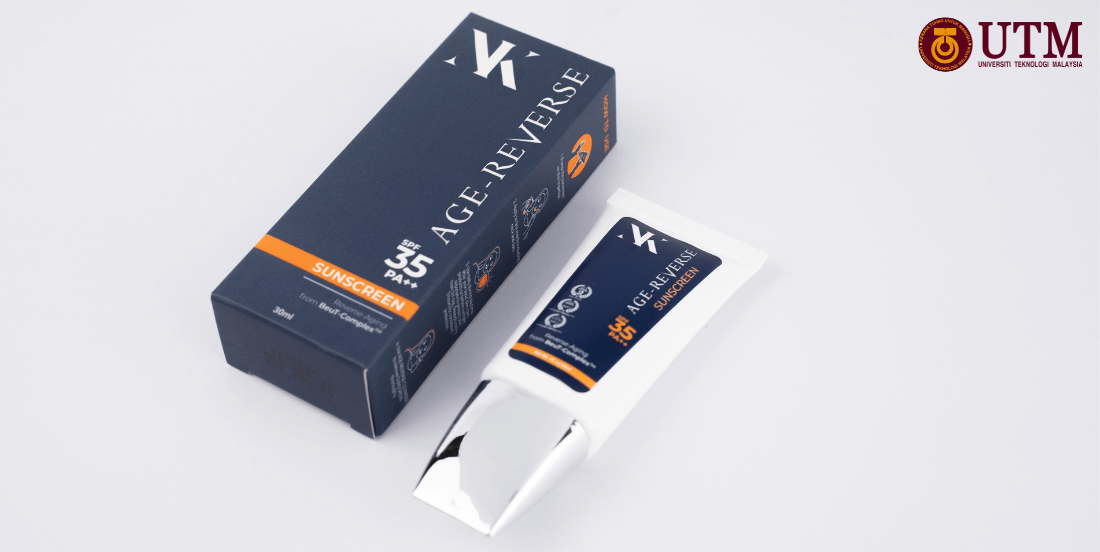No products in the cart.
Sunscreen, Tanyalah Dr.
Sunscreen : PHYSICAL & CHEMICAL and What The Different?

This article written by :
Venus Wong (R&D Department Manager NK Age-Reverse)
What Is Physical Sunscreen & What Is Chemical Sunscreen

Sunscreen comes in two major types: Chemical Sunscreens and Physical Sunscreens. Both types of sunscreen offer protection against UV radiation and damage.
Then, what make them so different?
Physical sunscreen—often called “Mineral sunscreen” or “natural sunscreen”—is a type of sun protection that uses minerals to safeguard your skin from UV rays.
Chemical sunscreen—also called “synthetic sunscreen” or “organic sunscreen” —is a type of sun protection that uses a mix of ingredients to prevent both UVA and UVB radiation from damaging your skin.
Notes:
There’s also third type of sunscreen that combine both of physical & chemical sunscreens called “Hybrid Sunscreens”, but it still not as safe as physical sunscreens. Mixture of TiO2 might cause another reaction which we’ll discuss it on other article.
How Do They Work?
Chemical sunscreens ingredients designed to absorb UV radiation from the sun, which catalyses a reaction that changes UV rays into heat, which is then released from the skin.
You’ve probably heard that physical sunscreen works by sitting on top of the skin surface and reflecting away UV rays. However, recent research Trusted Source suggests that physical sunscreens does not reflect or scatter the UV light, but actually protect skin by absorbing up to 95 percent of the UV rays.
According to source, all physical UV filters act as semi-conductors and absorb photons with electron shifts to a different valence band. So a harmful wavelength is converted to a less harmful or innocuous wavelength. That means physical sunscreen is just like “chemical” sunscreen in how it protects. Contrary to popular belief, all sunscreens work the same way, by absorbing harmful UV rays before they can inflict serious damage.
Hmmm… let just leave that for them to debate.
Instead discussing about the complex science behind how these 2 sunscreens work, let just talk about which one are most EFFECTIVE and SAFE. So, we should focus on what ingredients are these sunscreens used. Here some major differences between these Physical sunscreens vs Chemical sunscreens you should know!
Physical Sunscreen active ingredients
Physical sunscreens: There are two naturally-occurring minerals that you’ll find as active ingredients in these products: Zinc Oxide (ZnO) and Titanium Dioxide (TiO).
- Zinc oxide is derived from zinc, and ground into small particles between 30 and 200 nanometers in size. It can be present at concentrations up to 25%.
- Titanium dioxide is derived from titanium, and has a smaller particle size of 10 to 100 nanometers. It, too, can be used at concentrations as high as 25%.
Physical Filter | UVA | UVB |
Titanium Dioxide | ◕ Considerable protection | ● Extensive protection |
Zinc Oxide | ● Extensive protection | ● Extensive protection |
Zinc Oxide and Titanium Dioxide they are white minerals that do double duty. Zinc Oxide protects, on its own, against the entire UV range. Titanium Dioxide defends you from ALL UVB and MOST UVA rays by absorb most UV rays, turning them into a less damaging form of energy (heat) and reflect the leftover away from your face. Pretty impressive, huh?
Thanks to the presence of Titanium Dioxide and Zinc Oxide, these mineral tend to leave a white film on the skin which the main reason why most people not really like it especially those with darker skin tone.
Chemical Sunscreen active ingredients
Chemical sunscreens: Anything that are not ZnO or TiO2 is consider chemical sunscreen. There are more than 30 synthetic UV filters used to absorb UV rays as soon as they heat your skin and turn them into heat.
Chemical UV filters are mainly one trick ponies. They either protect from UVA or UVB rays. Avobenzone, for example, only protects your skin from UVA rays, But, it’s very unstable and degrades quickly when exposed to sunlight. While Oxybenzone works only against UVB rays.
Chemical Filter | UVA | UVB |
Avobenzone | ● Extensive protection | ◔ Limited protection |
Oxybenzone | ◕ Considerable protection | ● Extensive protection |
Octocrylene | ◔ Limited protection | ● Extensive protection |
Ecamsule | ● Extensive protection | ◔ Limited protection |
Cinoxate | ◔ Limited protection | ● Extensive protection |
Dioxybenzone | ◕ Considerable protection | ● Extensive protection |
Ensulizole | ○ Minimal protection | ● Extensive protection |
Meradimate | ◕ Considerable protection | ● Extensive protection |
Octinoxate | ◔ Limited protection | ● Extensive protection |
Octisalate | ○ Minimal protection | ● Extensive protection |
Padimate O | ○ Minimal protection | ● Extensive protection |
Sulisobenzone | ◕ Considerable protection | ● Extensive protection |
The U.S. Food and Drug Administration (FDA), which regulates sunscreen products, hasn’t labeled either type of sunscreen unsafe. But as of February 21, 2019, the FDA has proposed a rule to update regulatory requirements for sunscreen products sold in the United States.
As part of this proposed rule, the FDA has called for additional safety information on 12 active ingredients commonly found in chemical sunscreens: (Table.2)
A small randomized clinical trial published in May 2019 and January 2020 in the Journal of the American Medical Association (JAMA) revealed that four of these sunscreen chemicals (avobenzone, oxybenzone, octocrylene, and ecamsule) are absorbed into the bloodstream at significantly greater levels than 0.5 nanograms per milliliter (ng/mL). That’s far above the amount at which the FDA requires topical medications to undergo safety studies to determine possible toxic effects.
Although study authors say these results support the need for more research, they also say their findings don’t indicate that sunscreen is unsafe. What’s more, the known health risks of sun exposure far outweigh the potential risk of absorbing sunscreen chemicals.
Still, the Environmental Working Group (EWG) recommends avoiding chemical sunscreens with oxybenzone because of concerns that this ingredient may disrupt hormones and cause allergic skin reactions.
A review published in January 2019 in the Journal of the American Academy of Dermatology found that common chemical sunscreen ingredients such as oxybenzone may bleach and damage coral reefs and have been identified in various species of fish worldwide, which has possible consequences for the food chain.
For this reason, some tourist destinations, including Hawaii, have banned oxybenzone, as the Center for Biological Diversity notes.
Meanwhile, the ingredients in physical sunscreens — zinc oxide and titanium oxide — have been generally recognized as safe and effective by the FDA.
Read more : 11 material that you should avoid In chemical sunscreen
Should I Use A Physical Or Chemical Sunscreen?
Between the two types, physical sunscreens are generally the better, healthier option. But if look for better appearance on your skin (no white cast) instead of worrying about long term effect, chemical sunscreen is a way to go.
“Physical sunscreens are like a healthy, home-cooked meal, while chemical sunscreens are like the fast food of sunscreens”. Bottom line is, any sunscreen even if imperfect, is better than no layer of protection at all.
Please take note, there’s more to finding a good sunscreen than just checking for physical or chemical type. You also need to ensure you’re properly shielded from UVA and UVB—especially UVA, since it comprises the vast majority of UV rays and is the most damaging.
Here few more important factors you should consider when choosing the best sunscreen:
- SPF, what it is and which one better.
- Broad-spectrum sunscreen, why it provide the best protection.
- Extra features, such as moisturise the skin, combine technology to improve and treat skin condition.
Read more Benefit of physical sunscreens over chemical sunscreens
New Sunscreen Generation : The Physical Sunscreen That Not Leave a White Cast
Physical sunscreen formulation has undergone a major technological transformation over the recent past, resulting in improved sunscreen efficiency and safety. With advancement in nano-technology research, this zinc oxide and titanium dioxide now can be broken down into smaller particles to reduce the effect of white cast.
Thanks to this nano-technology advance in sunscreen research, the days of physical sunscreen with white case are now GONE.
NK Age-reverse Sunscreen developed by R&D research team from UTM was new generation of physical sunscreen that use a nano UV filter that is certified by COSMOS (an international independent association that certifies genuine natural cosmetics). It feels so lightweight, you won’t feel like you’re wearing them and leave almost no white cast .
You’ll get same feeling like using chemical sunscreen, but get protection and safe to use just as using physical sunscreen. With this, you get the best of both features in one 30ml cube.
Formulated together with anti-aging technology that won 35 international innovation awards, this is another world class product from our R&D lab to our fellow Malaysian. Best of all, it came at much more affordable price compare to international brand but work far more better.
About Author:
Venus Wong is the researcher and manager in R&D department for NK Age-Reverse which focus on research to improve the quality of skincare & invent a new product using latest technology. Her mission is to help inspire and motivate individuals to critically think about what they put in their bodies and to find balance through nutrition and lifestyle.
Note : NK Age-Reverse is a research base product lead by Assoc Prof Dr Siti Hamidah and researcher from UTM specifically made to improve skin issue among Malaysian. Get the latest of our innovation HERE.
References:
Age-Reverse.my has strict sourcing guidelines and relies on peer-reviewed studies, academic research institutions, and medical associations. We avoid using tertiary references.
- Metal oxide sunscreens protect skin by absorption, not by reflection or scattering.
- What Is Mineral Sunscreen? How It Works
- FDA advances new proposed regulation to make sure that sunscreens are safe and effective
- The trouble with ingredients in sunscreens
- Laboratory testing of sunscreens on the US market finds lower in vitro SPF values than on labels and even less UVA protection.
- Sun Protection Myths: Facts Versus Fiction
- Sunscreen: How to Help Protect Your Skin from the Sun
- Studies don’t change sunscreen guidance
- Dispersion and surface functionalization of oxide nanoparticles for transparent photocatalytic and UV-protecting coatings and sunscreens.





